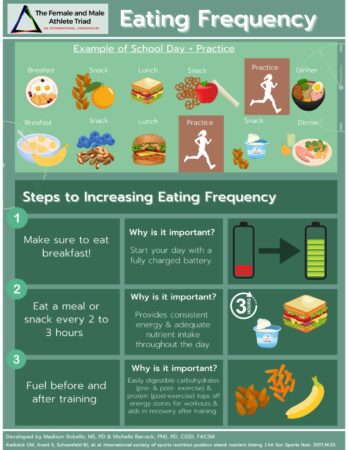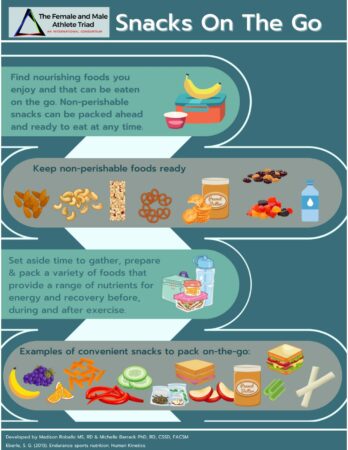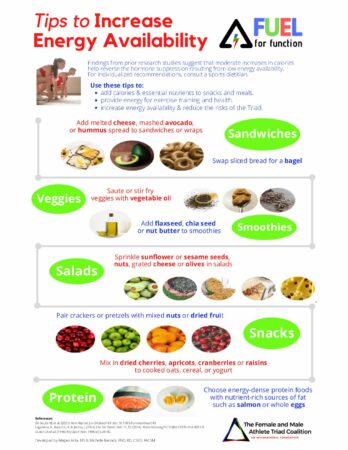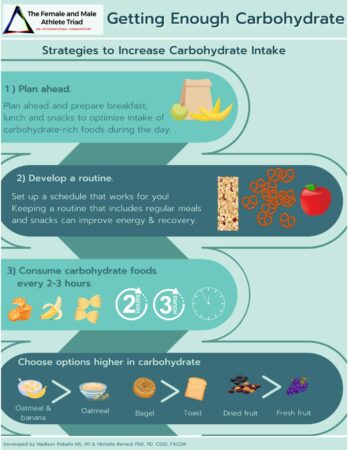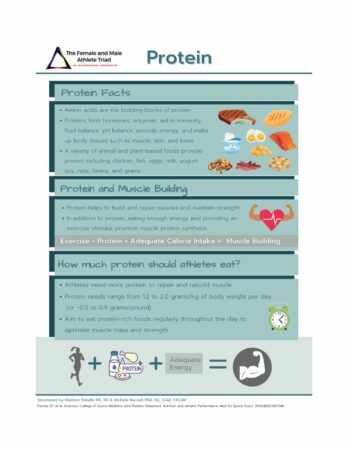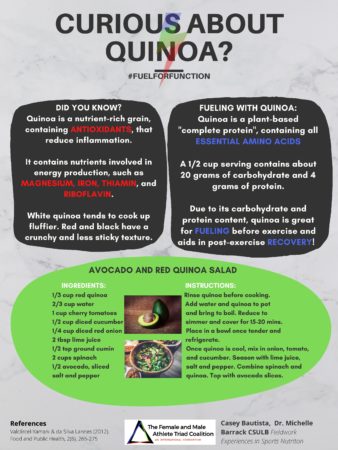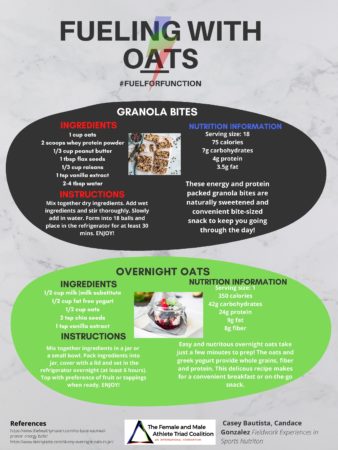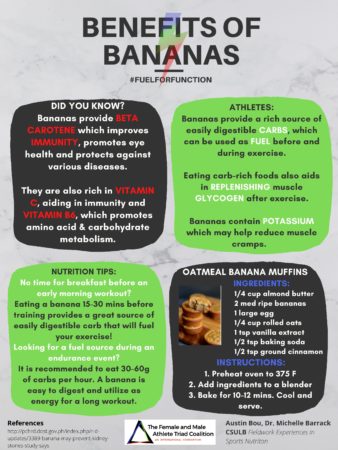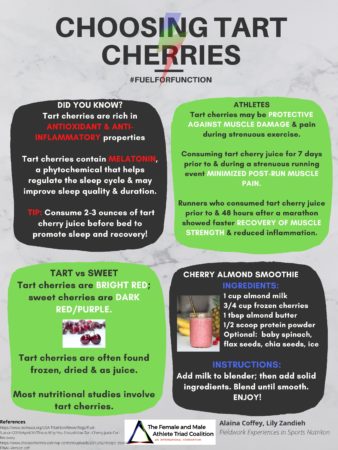Nutrition is not only a vital offensive tool to maximize your active lifestyle, but also a defense mechanism in preventing poor health conditions, such as The Female and Male Athlete Triad. By understanding the benefits of food, our hope is that you can decide your food intake more purposefully and truly come to see that food is fuel.
Each macronutrient plays a key role in physically active individuals’ exercise performance and health. Details regarding the specific role of each macronutrient and example food sources are described below.
The basic macronutrients include:
Carbohydrates = Energy
Let’s begin with the bottom line and build our way up: carbohydrates supply us with our most important tool – energy and fuel to power our exercise. Carbohydrates can be readily available for use when carbohydrate-rich foods are broken down into glucose or stored in our muscles and liver as glycogen.
What’s so important about energy?
Your body needs fuel to function, even at rest. This helps your organs to operate, body to regulate, and brain to function. Athletes and individuals with active lifestyles require more carbohydrates to make the most out of exercise sessions and optimize performance.
Athletes cannot train or perform well without having enough carbohydrates to fuel exercise. This is because carbohydrates provide about 50% of the energy an individual needs for moderate-intensity activity and up to 100% of the energy needed for high-intensity activity.
How many carbohydrates do physically active individuals need?
Experts in nutrition recommend that athletes, based on their level of exercise, consume 5 to 12 grams of carbohydrate per kilogram of body weight. For a 65 kg athlete (about 143 lb), this equates to approximately 325 to 725 grams of carbohydrate per day!
What foods contain carbohydrates?
Carbohydrates should come from nutrient-rich foods, containing vitamins and minerals that support energy production, recovery, bone health, immunity, oxygen delivery, fluid balance among many other important roles.
3 Types of Dietary Carbohydrates
Carbohydrates are fuel, however, not all carbohydrates are created equally. There are 3 different types of carbohydrates that offer different benefits to your body and, therefore, can be utilized at different times and places.
- Sugar
- Sugar can be naturally occurring in food, such as the sweetness of fruits, or added, like the sugar you’d use in your brownie recipe.
- Benefit: Sugars are fast acting. They provide energy that can be enacted quickly but not for long durations of time.
- It is best to choose foods with naturally occurring sugars such as fruits, vegetables, and plain low-fat milk or yogurt, which are also rich in vitamins and minerals.
- Starch
- Starchy carbohydrates include whole grain breads, cereal, rice, pasta, oats, barley, whole grain rice, beans, lentils, and starchy vegetables such as potatoes, peas, and corn.
- Benefits: Starchy carbohydrates provide us with longer-lasting energy.
- According to the 2015 Dietary Guidelines for Americans, at least half of all grains consumed should come from whole grain products. This is because whole grains include the outer layer of the grain (the bran), that provides fiber, B vitamins, and minerals, and the next layer (the germ), which includes fatty acids and vitamin E. These nutrients are removed when eating a refined grain.
- Fiber
- Fruits, vegetables, whole grains, nuts, seeds, beans and legumes contain an indigestible component called fiber.
- Benefits: Fiber is crucial for digestive health and also contributes to satiation (feelings of fullness).
Proteins are made up of long chains of amino acids. Our body can make some amino acids, but we must get other amino acids from our food.
Protein is responsible for building and maintaining your body. Consuming protein provides the amino acids necessary for constructing and maintaining bones, muscles, cartilage, and skin. Protein also functions in transporting oxygen, supporting healthy digestion, metabolism, immunity, fluid balance, and regulating hormones.
How does protein help active individuals?
Protein allows active individuals to maximize workouts by building muscle and boosting recovery, thereby preventing potential injuries due to breakdown. Protein also promotes feelings of fullness after and between meals.
How much protein do active individuals need?
Sedentary individuals need only 0.8 g/kg of body weight, however, physically active individuals need about twice that amount. Based on the nutrition experts, athletes should consume about 1.2 to 2.0g/kg of body weight. For a 65 kg athlete, this equates to 78 g to 130 g of protein per day.
What foods contain protein?
It is important to eat a variety of protein rich foods to get a range of the essential amino acids and vitamins and minerals.
Nutrient-rich sources of proteins include:
– lean beef, poultry, fish, eggs, and dairy foods
– plant-based sources include tofu, beans, legumes, nuts, seeds and some vegetables
There are many types of fats that are not only good for you, but essential. The types of fats naturally found in foods are monounsaturated, polyunsaturated, and saturated fats.
The “essential” unsaturated fatty acids that we must get from our food are linoleic acid and alpha-linolenic acid (found in walnuts, chia and flax seeds, oils, avocados, and fatty fish). Many food sources of healthy fats also contain a variety of vitamins and minerals.
How do dietary fats help active individuals?
Fat, like carbohydrate, is a major source of energy production during exercise. It is especially helpful in fueling long-duration exercise.
Fat is also important because it plays an important role in protecting key organs, absorbing fat-soluble nutrients (vitamins A, D, E, and K), supporting growth and brain development, synthesizing hormones, reducing inflammation, and aiding in immune system function.
What are nutrient-rich sources of dietary fat?
Choose a variety of foods rich in vitamins and minerals that contain dietary fat such as avocados, olives, nuts, nut butters, seeds (chia and flax seeds), and fatty fish (salmon, tuna, trout).
It is important to note that some foods contain types of fat that promote inflammation, heart disease, diabetes, and other health conditions if not consumed in moderation. Foods containing these sources of fats, that should be limited, include red meat, whole-fat dairy, lard, coconut/palm oil, baked pastries, prepackaged crackers and chips, fried foods, and hydrogenated/partially hydrogenated oils.
NUTRITION HANDOUTS
VIDEO RECIPES
Turmeric Red Lentil Soup
Purple Yam Brownies
Chia Seed Pudding
Video Recipes Courtesy of:
Corry Akbarian, MS, RD
M.S. Nutritional Science Directed Project
California State University, Long Beach
HELPFUL RESOURCES
Making Up for an Energy Deficit; Food and Meal Ideas
By Michelle Barrack PhD, RD
If you are at a loss regarding how to boost your food intake, these suggestions can help you start taking small steps towards improving your food intake.
Feeding the Active Female; Part II
By M. Manore, PhD, RD
ACSM Health & Fitness Journal, Sept/Oct 2005
This article offers nutrition advice for active women.
Fueling for Fitness: Recommendations for Foods and Fluids for Before, During and After Exercise
By N. Meyer, M Manore and J Berning
ACSM Health & Fitness Journal 2012, 16 (3): 7-12
Guide to Student Eating Disorder Awareness
Eating disorders are often misunderstood, misdiagnosed, and might be kept a secret. This in-depth guide explains what eating disorders are, how to spot the signs among peers, and what treatment are available for those experiencing a disorder
Website links
www.NationalEatingDisorders.org
www.MEDAinc.org
www.bulimia.com
The Gatorade Sports Science Institute provides several reviews of the scientific literature on topics related to sport and exercise nutrition. It is noteworthy that all reviews were written by international experts in their respective fields.
Want to find a sports dietitian who is skilled in working with athletes who struggle with food? Members of the Academy of Nutrition and Dietetics Sports, Cardiovascular, and Wellness Nutrition group (SCAN) are registered dietitians with nutrition expertise in the areas of sports, physical activity, wellness, and the prevention and treatment of disordered eating and eating disorders. Click HERE to find a SCAN dietitian.
POSITION STATEMENTS
In 2011, the NATA published a position statement on safe weight loss and weight maintenance strategies for athletes and exercisers. It is known that athletic trainers present an important source of information for athletes. The position paper addresses the primary motives for weight loss and highlights the importance of realistic body weight and body composition goals to attain safe weight loss.
Click HERE for the full position statement.
Together with the American Dietetic Association and Dietitians of Canada, the ACSM published a joint position statement on how optimal nutrition may improve athletic performance and the recovery from exercise. The position statement addresses the current scientific evidence on energy and nutrient needs and strategies for weight loss and weight gain. The statement further highlights nutrition strategies designed to optimize performance during training and competition and discusses the use of supplements and ergogenic aids by athletes and exercisers.
Click HERE for the full position statement.
Despite being published in 1996, this ACSM position statement addresses important questions for athletes who compete in sports with weight categories. The authors describe potential negative effects of rapid weight loss techniques on athletic performance, health, and growth. Further, the statement calls for strategies to educate coaches and athletes and for regulation changes in order to discourage excessive and unhealthy weight loss.
Click HERE for the full position statement.
In 2007, the ACSM published a position statement on hydration strategies during exercise and physical activity. The importance of appropriate hydration before, during, and after exercise is highlighted in this statement. The position statement provides evidence based recommendations for pre-exercise hydration and strategies to prevent hypohydration during exercise. The statement highlights that exercise-associated fluid and electrolyte losses may vary dramatically between individuals and presents practical strategies to estimate fluid losses during exercise.
Click HERE for the full position statement.




